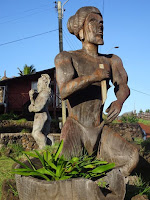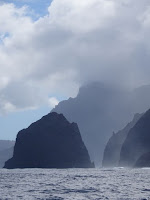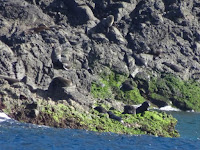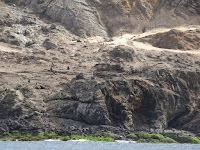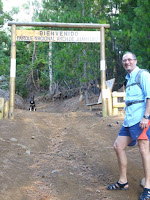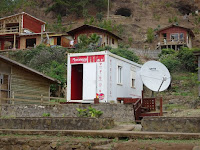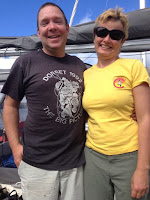It was worse for the other boats, who had elected to stay at Hanga Roa. Even before first light we could hear bits of conversation breaking through the squelch on the radio. Every one of them had had a miserable night and the talk was all about getting the hell out of there and going to the other side of the island.
By the time we weighed anchor, two of the others were already zinging around the point. By the time we had our sails up and pulling, they were half a mile ahead of us and a third boat was on our heels. Nemo, the fourth boat, elected to go the other way around the island and have a look at Anakena.
Damn! There was only one other anchorage on the protected side of the island, called Hotuiti, and too many boats were all racing for it. Our “Head start” didn’t count on the rest having their anchors up at the first hint of light. Depths there were also supposed to be 24m, which meant putting out all of our ground tackle, which would give us a swinging circle with a diameter of 350m. The info we had indicated that there was nowhere near enough real estate for four boats to do that simultaneously.
To complicate matters, the other boats were going back and forth on the radio with the Armada about what to do. When they announced their plans to go to Hotuiti, the Armada came back and said it wasn’t safe. The conversation was broken, but after several tries, we heard the Armada say,”The charted position at Hotuiti is unsafe now because of rocks.” Rocks are bad because, a: an anchor can get wedged in a gap and be irretrievable at 24m without SCUBA gear, and 2: chain can wrap around them as the boat swings. This can reduce or eliminate the sag of the caternary and thus the chain’s ability to absorb shock, making it more likely to snap or rip the bow roller out of the deck. They recommended Anakena on the third side of the triangular island. Anakena was protected from the long swell arriving from the south, but not from the strong north winds. Since all four of us had to sail past Hotuiti to get to Anakena, the other boats explained they would have a look at it anyway as they went by. The Armada stopped short of outright prohibiting them to do so, although it sounded like they really wanted to. They just kept saying in an authoritative voice that. “Hotuiti is unsafe. Recommend Anakena.”
I keep saying “they” because we could never reach the Armada on the radio ourselves. We had started under the cliffs at Vinapu and were sailing closer to shore than the others, so our antenna may have been blocked by terrain. By the time we were all halfway to Hotuiti, the Armada said they would lose us all because their coverage was bad on the eastern side of the island.
Since we couldn’t get them by radio, we sent them an email via satellite. Technically, we were supposed to request a reposition before we left, but Vinapu was deteriorating, so we left first and then asked. The Armada here is pretty cool and we were sure they would understand. One of the three other boats on our side of the island considered stopping at Vinapu and we talked them out of it, explaining that we were bailing out. There was subsequent talk about “another catamaran” and “a fourth boat”, so we figured the Armada was in the loop.
An hour or so later, we received a short email reply saying, “Reposition Hotuiti approved.” Great!
As the four of us approached the anchorage there, it looked like a huge mess. A big swell was rolling in and turning into great big surf crashing onto the rocky shore. The group of three had been spooked by rock problems in Hanga Roa and didn’t even alter course toward the anchorage. They just sailed on by and pretty soon were disappearing around the island. The Three went to Anakena. Nemo ended up at La Perouse, in the next bay over from them.
We decided to have a look at Hotuit anyway for a couple of reasons. First was that the bay had an outcrop of rock on one side. We have been a few places where that is all that is needed to diffuse the swell and create a milder patch inside that is not apparent from further out. Second, we had the list of anchor positions for each of the island’s five anchorages, but we also had found another obscure source of info that told of a triangle (like Bermuda, only a lot smaller) of coral-free sand at a slightly different location in the bay. I was really hoping it was true.
Fortunately, the water at Easter is so clear that it’s easy to see the bottom way down at 24m. I stopped the boat in the middle of the triangle and it was indeed good, clean sand. We were outside of the surf in long 2m swell. We dropped the anchor and then let out everything we had. Up at the surface, it still felt like we were on a pretty rough sail. We had 72m of chain out, with its caternary, plus 90m of nylon rode, which can stretch another 36m before reaching 50% load, plus two high load bungees on each leg of our bridle. The idea is that we can heave up and down and sway and surge a few boat lengths each way without the anchor having to know about any of it because the shock has all been absorbed by then.
This, of course was all dependent on us not getting it all wrapped around a rock or coral head. While Maryanne wrote the Armada telling them we were safely anchored, I went for a long reconnaissance swim to check things out. I first swam to the anchor, which I couldn’t see. I saw our trip line emerging from the sand and about 15m behind it, the anchor chain appeared along the sea floor. It was good and buried and the first half wasn’t even moving. Excellent! I then swam a big spiral around the boat to find where the sand ended and to make note of any obstructions we might get wrapped around. To my surprise, the triangle was all sand and everything out of it was mostly coral heads and rock. I swam a long way and could not find another spot with a large enough patch of sand to lay out our chain. We had the one spot in the bay. It was uncomfortable on board, but we weren’t going anywhere.
When I climbed back aboard, Maryanne said, “We got an email from the Armada. You’re not going to like it.”
She was right. It was clearly translated using software. It was pretty incomprehensible, but it did not sound good. Here is the text in its entirety:
GOOD AFTERNOON CAPITAN
I HOPE YOU ARE GOOD, YOUR YACHT MUST STAY FUNDED IN HOTUITI RECEPTION IT WILL BE CARRIED OUT ONCE YOU SURRENDER IN THE HAGUE ROA BAY FOR ALL THE AUTHORITIES INVOLVED
IT IS FORBIDDEN TO DROP TO EARTH AND TO LEAVE THE YACHT
What!? I read it over and over and couldn’t figure it out. The one part that did seem pretty clear was the last line. In Spanish, ‘Earth’ and ’Land’ are the same word. ‘Drop to land’ is an expression meaning ‘to land’ or, ‘make a landing’. What was the point of coming to Hotuiti to escape the next six days of north winds if we couldn’t go ashore? Was it because they thought Hotuiti was too dangerous? Or were we being punished for not contacting them before we left Vinapu?
We were sure there was some kind of misunderstanding, but the only way to clear it up was to ask for clarification, which would mean acknowledging that we got their email. If we did that, we would lose the ability to make the argument, thin as it was, that we never got their message and didn’t know we couldn’t go ashore, which we really wanted to do because that’s why we sailed all the way here in the first place.
We took a deep dive into the rest of the email. ‘Funded’ was a misspelling of one of their common words for ‘anchored’. In Spanish, the word for ‘surrender’ is also used for report (as in to report) and deliver. That made it sound slightly less ominous, but still almost as confusing.
It was cleared up when we got a call from the Armada on the radio. I told the guy I was surprised to hear from him because I thought they said they had no signal here. He told me he was in a truck doing a lap around the island to check on all of the yachts. He flashed his headlights so we could see. He then started peppering us with questions about our last port, next port, crew aboard, etc., as if we hadn’t already told them all of that in Hanga Roa. That’s when it dawned on us that he thought we were a new international arrival that hadn’t cleared in yet. In that context, the email makes perfect (or at least more) sense: Don’t go ashore until you have reported at Hanga Roa for clearance. When we explained what happened to him, he asked us if we felt we were safely anchored where we were. We said yes and he then said to have a nice time on the island. The ride on the emotional roller coaster was over almost as quickly as it started – just like regular roller coasters.
It was getting dark already, so we were relieved to give ourselves permission to call it a day. Sitting in the cockpit, looking ashore, we decided we had the best view of any anchorage on the island. From where Begonia rolled and swayed, we could see no rusty oil tanks, only rolling hills of gold and green and blue surf crashing into white spray on volcanic rocks. Beyond, the fifteen moais of Tongariki stood perfectly centered and facing the Rano Raraku volcano from which they were created.



